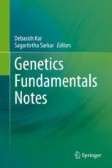Search
Search Results
-
WasC, a WASP family protein, is involved in cell adhesion and migration through regulation of F-actin polymerization in Dictyostelium
The actin cytoskeleton is involved in the regulation of cell morphology and migration. Wiskott-Aldrich Syndrome proteins (WASPs) play an important...
-
Inhibition of KIF20A suppresses the replication of influenza A virus by inhibiting viral entry
The influenza A virus (IAV) has caused several pandemics, and therefore there are many ongoing efforts to identify novel antiviral therapeutic...
-
Developmental Genetics
The foundation of the genetic approach to understand the development of an organism is that all the information is already encoded in an organism’s...
-
Schizosaccharomyces pombe comparative genomics; from sequence to systems
The fission yeast Schizosaccharomyces pombe is becoming increasingly important as a model for the characterization and study of many globally...
-
Biological Role of Actin Isoforms in Mammalian Cells
Actin plays an important role in cellular adhesion, muscle and non-muscle contractility, migration, polarization, mitosis, and meiosis. Investigation...
-
Common and Specific Functions of Nonmuscle Myosin II Paralogs in Cells
Various forms of cell motility critically depend on pushing, pulling, and resistance forces generated by the actin cytoskeleton. Whereas pushing...
-
Rice RHC Encoding a Putative Cellulase is Essential for Normal Root Hair Elongation
Root hairs are tubular shaped protuberances of root epidermal cells and are found in nearly all vascular plants. Co-ordinate expression of a number...
-
Functional Characterization of Septin Complexes
Septins belong to a family of conserved GTP-binding proteins found in majority of eukaryotic species except for higher plants. Septins form nonpolar...
-
Participation of Septin Cytoskeletal Proteins in the Nervous System Functioning
Septins, the cytoskeletal proteins discovered in the 1970s in budding yeast cells, are currently detected in most postmitotic cells of animals and...
-
Intracellular cargo transport by kinesin-3 motors
Intracellular transport along microtubules enables cellular cargoes to efficiently reach the extremities of large, eukaryotic cells. While it would...
-
Biological effects of the symbiosis between insects and intracellular bacteria Wolbachia pipientis
Only a few decades ago, symbiosis between insects and bacteria was considered a relatively rare phenomenon. The concept of symbiosis has changed in...
-
The role of sbr/Dm nxf1 gene in syncytial development in Drosophila melanogaster
Syncytial development is a property of early embryogenesis and spermatogenesis in Drosophila melanogaster . All elements of syncytium are linked in a...
-
Plasma membrane organization promotes virulence of the human fungal pathogen Candida albicans
Candida albicans is a human fungal pathogen capable of causing lethal systemic infections. The plasma membrane plays key roles in virulence because...
-
Hgc1-Cdc28–how much does a single protein kinase do in the regulation of hyphal development in Candida albicans?
The fungal human pathogen Candida albicans can cause invasive infection with high mortality rates. A key virulence factor is its ability to switch...
-
Players at plasmodesmal nano-channels
Plasmodesmata (PD) are the nano-channels connecting the adjacent plant cells. These functional tiny holes in the plant cell wall allow the symplasmic...
-
Phosphoinositide-dependent perimembrane mechanisms of regulating cellular processes
Phosphoinositides are minor phospholipids of cytosolic membrane surface involved in the regulation of vital cellular processes, including membrane...
